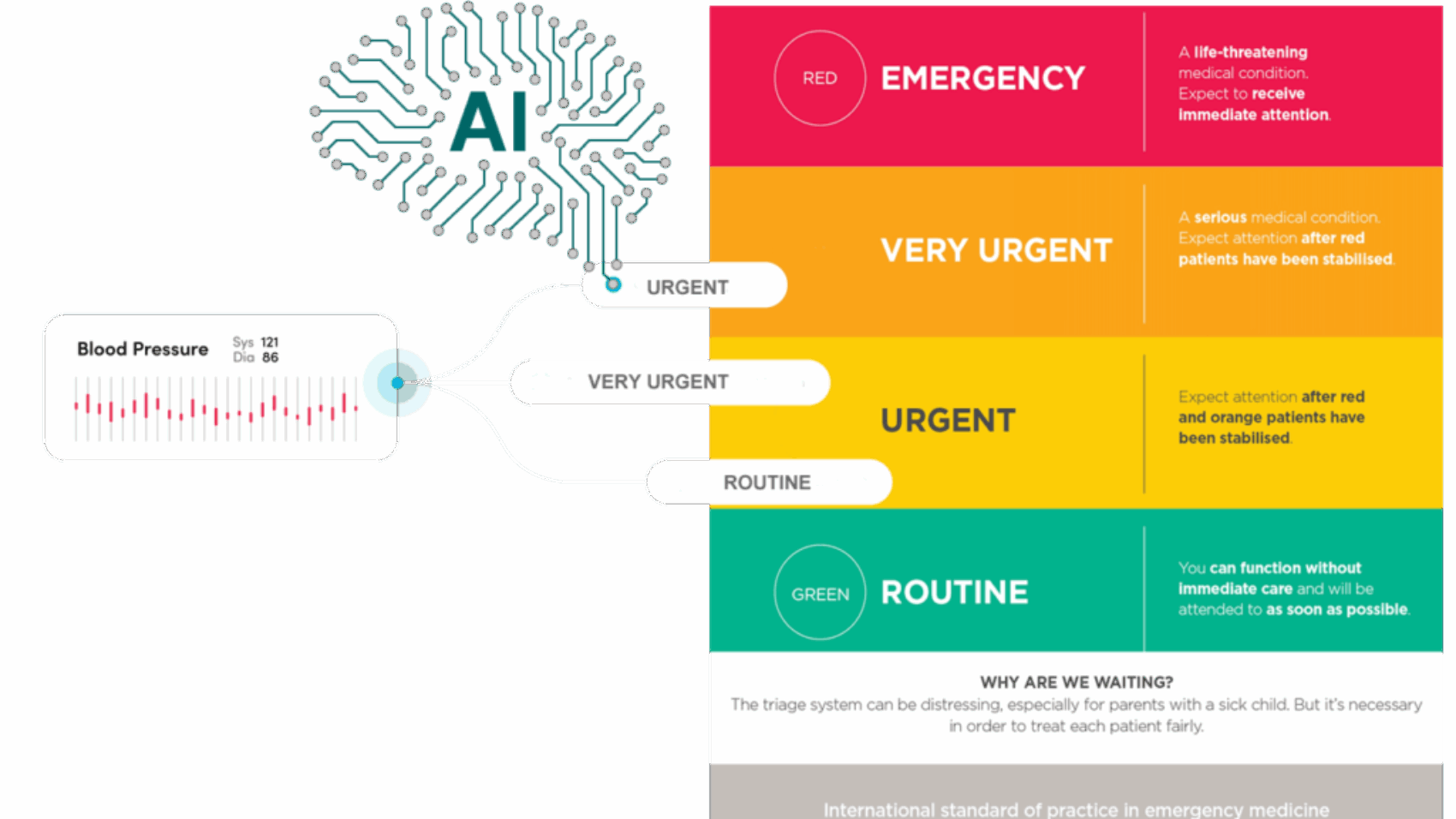The AI Triage by Carepoi revolutionizes the patient care process by integrating AI technology to manage triage efficiently. This system allows patients to self-triage at various Points of Interest (POI), whether in a hospital, clinic, or at home. It reduces waiting times, enhances decision-making accuracy, and frees up healthcare staff from administrative tasks. By analyzing patient data in real-time, it ensures quick and accurate triage, enabling healthcare professionals to focus on critical care. AI-driven predictions improve patient flow and streamline emergency management, promoting faster and better healthcare delivery.
What is AI Triage?
AI Triage is a cutting-edge system designed to automate and streamline the triage process in healthcare. By leveraging advanced artificial intelligence, it allows patients to assess their symptoms and medical history, receiving instant guidance on the next steps in their care. This can include referrals, video consultations, or scheduling in-person and telehealth appointments. Integrated into one platform, AI Triage ensures swift, accurate decision-making, improving access to appropriate care while reducing administrative strain on healthcare professionals. This seamless technology is available for use across various healthcare settings, enhancing both patient experience and operational efficiency.
The Key Components of AI Triage
The AI Triage system consists of two primary components that work in tandem to enhance both the patient and clinician experience:
1) Unattended AI Triage
Unattended AI Triage by Carepoi operates autonomously, processing referrals through an API interface. The system evaluates urgency and makes predictions, such as recommending tests or scheduling follow-ups. If the referral meets automation criteria, AI Triage can automatically trigger next steps, like forwarding the referral to the booking team for further action. This reduces human intervention and speeds up the triage process.
2) Attended Virtual Assistant
The Attended Virtual Assistant (VA) aids clinicians by automating routine tasks like communicating with general practitioners for tests or advice. This allows healthcare providers to focus on more complex patient needs while the VA handles administrative duties. By streamlining these processes, the system improves efficiency and reduces clinician workload, making care delivery faster and more effective.
The Impact of AI Triage
The implementation of AI Triage in healthcare settings has had a profound impact, driving improvements in several key areas:
Faster Triage Process
AI Triage can complete a triage evaluation in just a few seconds, a significant improvement over the traditional method, which can take clinicians 4 to 5 minutes. This speed ensures that patients can be assessed and directed to the appropriate care without delay, reducing wait times and improving overall efficiency.
Reduction in Variability
By relying on AI algorithms trained on large volumes of historical data, the system significantly reduces unwarranted variations in triage decision-making. This consistency leads to more predictable and reliable outcomes for patients, minimizing the risk of errors or misclassifications that can sometimes occur with human judgment.
Lower Administrative Burden
Healthcare providers often struggle with administrative overload, which can lead to clinician burnout. AI Triage alleviates this burden by automating routine tasks, such as processing referrals and generating recommendations. This reduces the time clinicians spend on administrative work, enabling them to focus on patient care and decision-making.
Shorter Waiting Lists
The automation and efficiency provided by AI Triage actively manage the triage process, reducing waiting list times for patients. By quickly identifying those who require immediate attention and routing them to the right care pathway, the system ensures that patients are seen when they need to be, helping to prevent backlogs and reducing overall waiting times.
Facilitated Collaboration Across Care Levels
AI Triage fosters better collaboration between primary and secondary care providers. By delivering consistent and timely triage assessments, the system helps healthcare providers communicate more effectively and make coordinated decisions about patient care.
AI Triage in Action: Speed, Accuracy, and Availability
One of the standout features of the AI Triage by Carepoi is its speed, with predictions being made in mere seconds. This is especially important in emergency settings where timely intervention can be the difference between life and death. For comparison, while an experienced clinician might take several minutes to assess a patient, AI Triage completes the evaluation almost instantaneously.
Moreover, the system runs 24/7, meaning that patient referrals are processed immediately upon receipt, regardless of time of day. This round-the-clock availability ensures that patients never have to wait long for an initial assessment, even outside regular working hours.
AI Triage excels in accuracy, relying on large-scale historical data to ensure reliable performance. Trained extensively, it achieves a remarkable 97% accuracy rate in assessments. The system gathers over 50 clinical decision points, such as vital signs, test results, and symptom inputs. Advanced algorithms and certified triage protocols are applied to each case, enabling precise evaluation. This results in highly effective triaging, reducing the risk of error and ensuring patients receive appropriate care in a timely manner. This combination of accuracy and speed enhances the efficiency of the healthcare process.
Benefits for Patients and Healthcare Providers
AI Triage offers patients a fast, accurate, and accessible way to assess their symptoms and medical history, all from the comfort of their home or any other Point of Interest (POI). It connects patients with healthcare providers through video consultations or telehealth appointments, empowering them to manage their health. In emergencies, the system automatically directs them to the right care, such as urgent care or specialists, ensuring timely and appropriate treatment.
For healthcare providers, AI Triage significantly reduces the administrative burden of traditional triage processes. This allows clinicians to focus on delivering high-quality care. The system provides accurate, data-driven insights, enhancing decision-making and ensuring consistency. Moreover, by reducing waiting times, it improves efficiency and ensures that patients receive timely attention, ultimately streamlining the overall care delivery process.
Closing Thoughts
AI Triage is poised to revolutionize the way healthcare is delivered, offering patients a faster, more accurate, and more accessible way to triage their symptoms and connect with the appropriate care. By reducing administrative burdens, improving collaboration across care levels, and enhancing the overall efficiency of the healthcare system, AI Triage has the potential to greatly improve patient outcomes and transform the healthcare experience for both patients and providers alike. With its speed, accuracy, and 24/7 availability, AI Triage is a vital tool for the future of healthcare, ensuring that patients receive the right care at the right time.

